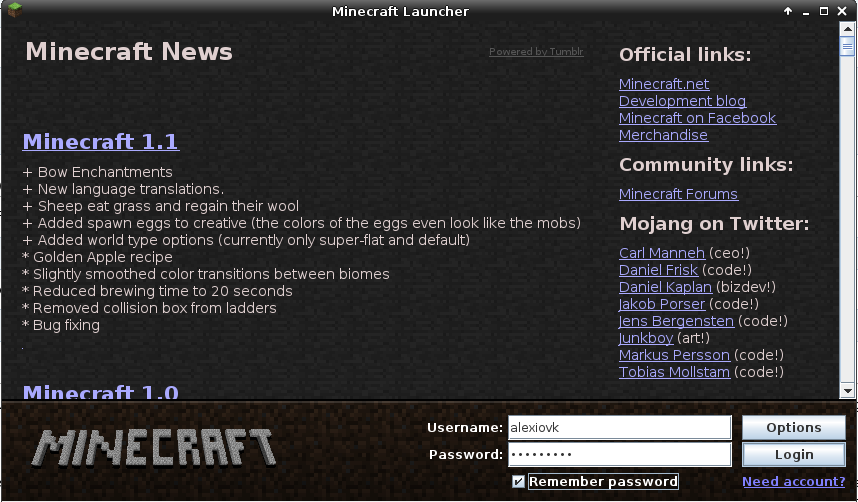Article by AlexioBash published on his website about ArchLinux in italian.
In this guide we will see two possible ways to install it on ArchLinux, how to get an account and what are the requirements.
Requirements
Get an Account
The game, not free, costs only € 19.95, although you may find it even at less with some special promotion. An expense that is worth doing! To create an account, simply register at the official website: www.minecraft.net
Dependencies
Minecraft, as already said, is a game based on java. To install Java, I suggest to read THIS < a> article directly from the WiKi of ArchLinux.
The package that we recommend is OpenJDK6 to install it open a terminal and run the command:
$ sudo pacman -S openjdk6 openal |
Installation
Installing from AUR
The Minecraft package is available directly from AUR and you can install it using the command:
$ yaourt -Sy minecraft |
Once the installation is complete you can launch the game from the terminal with the command:
$ minecraft
or through the entry “ Minecraft ” in the “ Applications/Games ” menu.
Manual Installation
The manual installation provides many benefits, one of the most important is the ability to choose how much ram assign to the game, which we will see later. To install this fantastic game you have to first download the .jar file.
It can be downloaded directly from HERE or by running the command:
$ wget http://www.minecraft.net/download/minecraft.jar |
Once the download is complete install the packages openal and OpenJDK6 with the command:
$ sudo pacman -S openal openjdk6 |
let’s make the downloaded file executable with the command:
$ chmod +x minecraft.jar |
To start the game, run the command:
$ java -jar minecraft.jar |
If we want to, as mentioned earlier, allocate more memory RAM to the game, the command will be:
$ java -jar -Xms1024M -Xmx2048M minecraft.jar |
where:
Xms = memory allocated in the start of the Java process.
Xmx = maximum memory the Java process can use.
For more info visit the official wiki.
Sponsored Server
Dark-Linux sponsor the NERDCRAFT server on nerdnest.it.
This server is sponsored by Dark-Linux having as OS: ArchLinux.
* To be enabled on the server you’ll have to register in the Forum of NerdNest and obtain the access from the relevant section, posting that you have been invited by Dark-Linux.
Have FUN!!
Popular Posts:
- None Found



[…] […]
First of all, pacman -Sy is unsupported. please change it to either pacman -Syu or pacman -S. If you do -Sy, then next time you install something you need to -Su.
Second, you don’t need openjdk6 to play minecraft, you can use openjdk 7 which is more recent and keeps people from having to uninstall their stuff to follow your guide.
https://wiki.archlinux.org/index.php/Minecraft#openJDK7
please fix this as it will break installs…
Hello Daniel,
Thanks for the feedback.
I’m changing the post right now.
Best Regards
You don’t need to make .jar files executable. Although they are programs in a sense (for the java virtual machine), from the perspective of the operating system they are normal files that are read by a program called java.
As a rule of thumb: if it’s never the first word on the command line, it doesn’t need to be executable.
Also note that .jar files don’t start with a line like “#!/usr/bin/java” or “#!/bin/env java” or something like that, which the OS needs to know how to run an executable that isn’t a real binary (that is, a script or a “binary” for a VM).
there is for some weeks (?) an open-source game called MineTest C55 that is taking the concept and making it open for everybody to improve and contribute mods, art, whatever…
you can find it at http://www.minetest.com 🙂
Enjoy!